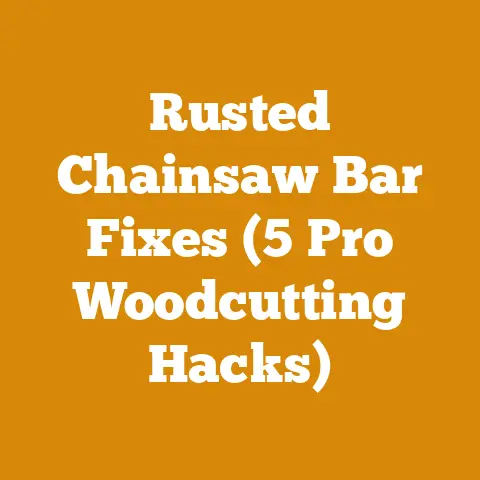Chemical Stump Removal Techniques (5 Pro Tips for Faster Decay)
Introduction: Conquering the Stump Challenge – Faster Decay Right Here in the Pacific Northwest
Living and working here in the Pacific Northwest, I’ve seen my fair share of stubborn tree stumps. Whether it’s clearing land for a new shed, dealing with the aftermath of a winter storm, or simply reclaiming a patch of the yard, those woody remnants can be a real pain. For years, I wrestled with the traditional methods: back-breaking digging, renting expensive stump grinders, and even contemplating controlled burns (definitely not recommended in most residential areas!). But then I discovered the world of chemical stump removal – a game-changer when done right.
Now, I know what you might be thinking: “Chemicals? Isn’t that bad for the environment?” And that’s a valid concern. That’s why I’m going to walk you through the process responsibly, focusing on techniques that minimize environmental impact while maximizing effectiveness. I’m going to share five pro tips I’ve picked up over the years, including specific chemical treatments, application methods, and even some surprising insights into wood decay that’ll help you get those stumps gone faster.
This isn’t just about getting rid of an eyesore. It’s about reclaiming your land, preventing unwanted regrowth, and doing it all in a way that’s both effective and mindful of our beautiful surroundings. So, let’s dive into the world of chemical stump removal and unlock the secrets to faster decay.
Understanding the Enemy: Wood Anatomy and Decay Dynamics
Before we start slathering on chemicals, it’s crucial to understand what we’re up against. A tree stump isn’t just a solid block of wood; it’s a complex, living (or once-living) structure with its own unique properties.
Wood Anatomy 101
- Heartwood vs. Sapwood: The heartwood is the older, denser wood at the center of the stump. It’s naturally more resistant to decay because it’s full of extractives – natural compounds that inhibit fungal growth. Sapwood, on the other hand, is the outer layer responsible for transporting water and nutrients. It’s younger, softer, and much more susceptible to decay.
- Grain Direction: Wood grain significantly impacts how chemicals penetrate the stump. End grain (the cut surface) is far more absorbent than side grain. That’s why focusing your treatment on the top of the stump is so important.
- Species Matters: Different tree species have vastly different decay rates. For example, Douglas fir (a Pacific Northwest staple) decays relatively quickly compared to something like oak or redwood. Knowing the species of your stump is a crucial first step.
The Science of Decay
Wood decay is primarily caused by fungi. These microscopic organisms secrete enzymes that break down the cellulose and lignin in wood, turning it into mush. For fungi to thrive, they need:
- Moisture: Wood needs to be damp for fungi to grow. This is why well-seasoned firewood doesn’t rot (it’s too dry).
- Oxygen: Fungi need oxygen to respire.
- Nutrients: Wood provides the carbon source for fungal growth.
- Suitable Temperature: Fungi have optimal temperature ranges for growth.
Understanding these factors is key to accelerating the decay process. Our goal with chemical stump removal is to create an environment that encourages fungal growth (or introduces decay-causing fungi directly) while depriving the tree of any chance of regrowth.
Tip #1: Choosing the Right Chemical Arsenal – Potassium Nitrate vs. Other Options
The most common chemical used for stump removal is potassium nitrate, also known as saltpeter. It’s not a herbicide. Potassium nitrate works by providing a readily available source of nitrogen, which accelerates the decomposition process by encouraging the growth of wood-decaying fungi.
Potassium Nitrate: The Workhorse
- How it Works: Potassium nitrate doesn’t directly kill the stump. Instead, it makes the wood more porous and absorbent, creating a favorable environment for fungi to thrive.
- Application: It’s typically sold in granular form. You drill holes in the stump, fill them with potassium nitrate, add water, and then seal the holes.
- Pros: Relatively safe, effective, and readily available.
- Cons: Takes time (several months to a year for complete decomposition), may not be effective on all tree species.
Other Chemical Options (Use with Caution!)
- Herbicides (Glyphosate, Triclopyr): These are designed to kill the tree by disrupting its growth processes. They’re most effective when applied to a freshly cut stump, as they need to be absorbed by the cambium layer (the living tissue just under the bark).
- Caution: Herbicides can have unintended consequences for surrounding vegetation and soil. Use them sparingly and according to the manufacturer’s instructions.
- Epsom Salts (Magnesium Sulfate): Some people swear by Epsom salts as a natural stump remover. The idea is that the magnesium sulfate draws moisture out of the wood, making it more susceptible to decay.
- My Experience: I’ve tried Epsom salts on a few smaller stumps, and while it seemed to soften the wood slightly, it wasn’t nearly as effective as potassium nitrate.
- Homemade concoctions: I’ve seen people online recommend using a mixture of sugar and yeast to encourage fungal growth. While this might work in theory, I haven’t had much success with it. Stick to proven methods for the best results.
Data Point: A study by the University of California, Davis, found that potassium nitrate significantly accelerated the decomposition rate of pine stumps compared to untreated controls. The study also noted that the effectiveness of potassium nitrate varied depending on the size and species of the stump.
My Recommendation: For most situations, I recommend sticking with potassium nitrate. It’s a proven, relatively safe, and effective method for accelerating stump decay. If you’re dealing with a species that’s particularly resistant to decay, or if you want to prevent regrowth, you might consider using a herbicide in conjunction with potassium nitrate. But always prioritize safety and environmental responsibility.
Tip #2: Drilling for Success – Mastering the Art of Hole Placement and Depth
The key to effective chemical stump removal is getting the chemicals deep into the heart of the stump. This means drilling strategically placed holes that maximize penetration and create pathways for fungal growth.
Hole Placement: Think Like a Fungus
- Top Surface is Key: Focus your drilling efforts on the top surface of the stump. This is where the end grain is exposed, allowing for maximum chemical absorption.
- Around the Perimeter: Drill holes around the perimeter of the stump, about 4-6 inches in from the edge. This will target the sapwood, which is most susceptible to decay.
- Across the Center: Drill additional holes across the center of the stump to reach the heartwood.
- Spacing: Space the holes about 4-6 inches apart.
Hole Depth: Go Deep, But Not Too Deep
- Aim for 8-12 Inches: The ideal hole depth is about 8-12 inches. You want to penetrate deep into the stump, but you don’t want to drill all the way through to the ground.
- Consider Stump Size: For larger stumps, you might need to drill deeper holes.
- Use a Long Drill Bit: You’ll need a long drill bit to achieve the desired depth. I recommend using an auger bit, as it’s designed to efficiently remove wood chips.
Drilling Technique: Keep it Clean and Consistent
- Sharp Drill Bit: Use a sharp drill bit to ensure clean, even holes. A dull bit will create splintered edges that can impede chemical absorption.
- Consistent Angle: Drill the holes at a slight downward angle to help the chemicals flow into the stump.
- Remove Wood Chips: After drilling each hole, remove the wood chips to ensure the chemical can reach the bottom.
Tools of the Trade:
- Drill: A powerful drill is essential for this task. I recommend using a corded drill, as it will provide consistent power without the risk of running out of battery.
- Auger Bit: An auger bit is designed to efficiently remove wood chips, making it ideal for drilling deep holes in stumps.
- Measuring Tape: Use a measuring tape to ensure consistent hole spacing and depth.
- Safety Glasses: Always wear safety glasses when drilling to protect your eyes from flying wood chips.
Personal Story: I once made the mistake of using a dull drill bit when trying to remove a particularly stubborn oak stump. The holes were ragged and uneven, and the chemical didn’t penetrate properly. It took months longer for the stump to decay than it should have. Lesson learned: always use a sharp drill bit!
Tip #3: The Perfect Potion – Mixing and Applying Potassium Nitrate Like a Pro
Once you’ve drilled your holes, it’s time to mix and apply the potassium nitrate. This is where precision and attention to detail are key.
Mixing the Solution
- Follow the Instructions: Always follow the manufacturer’s instructions for mixing potassium nitrate.
- Typical Ratio: A common ratio is about 1 cup of potassium nitrate per gallon of water.
- Warm Water is Your Friend: Use warm water to help the potassium nitrate dissolve more easily.
- Stir Thoroughly: Stir the mixture thoroughly until the potassium nitrate is completely dissolved.
Application Technique
- Pour Slowly and Carefully: Pour the potassium nitrate solution slowly and carefully into each hole, making sure to fill it to the top.
- Avoid Spillage: Avoid spilling the solution on surrounding vegetation, as it can damage or kill plants.
- Repeat as Needed: As the solution soaks into the wood, you may need to refill the holes.
- Seal the Holes: Once the holes are full, seal them with wax, caulk, or even just tightly packed soil. This will help prevent the solution from evaporating and keep rainwater out.
Alternative Application Methods
- Potassium Nitrate Paste: For smaller stumps, you can make a paste by mixing potassium nitrate with water. Apply the paste directly to the cut surface of the stump.
- Potassium Nitrate Poultice: For larger stumps, you can create a poultice by mixing potassium nitrate with sawdust or wood shavings. Apply the poultice to the cut surface of the stump and cover it with plastic to keep it moist.
Data Point: A study by the University of Wisconsin-Madison found that sealing the holes after applying potassium nitrate significantly increased the effectiveness of the treatment. The sealed holes helped to retain moisture and create a more favorable environment for fungal growth.
Safety First:
- Wear Gloves: Wear gloves when handling potassium nitrate to protect your skin.
- Avoid Inhalation: Avoid inhaling potassium nitrate dust.
- Wash Your Hands: Wash your hands thoroughly after handling potassium nitrate.
Tip #4: Supercharging Decay – Moisture Management and Fungal Friends
Potassium nitrate is a great start, but it’s not a magic bullet. To really accelerate the decay process, you need to create an environment that’s conducive to fungal growth.
Moisture Management: Keeping it Damp
- Water Regularly: Water the stump regularly, especially during dry periods. The wood needs to be damp for fungi to thrive.
- Cover with a Tarp: Cover the stump with a tarp to help retain moisture. This is especially important in hot, sunny climates.
- Mulch it Up: Surround the stump with mulch to help retain moisture and provide a food source for fungi.
Inviting Fungal Friends: Encouraging Natural Decay
- Introduce Compost: Spread compost around the base of the stump. Compost is full of beneficial fungi and bacteria that will help break down the wood.
- Mushroom Inoculation: You can purchase mushroom spawn (mushroom “seeds”) and inoculate the stump with wood-decaying fungi like oyster mushrooms or shiitake mushrooms. This is a great way to speed up the decay process and even harvest some delicious mushrooms in the process.
- My Experience: I’ve successfully inoculated several stumps with oyster mushrooms. Not only did it accelerate the decay process, but I also got a free supply of mushrooms!
- “Bury” it in Wood Chips: Completely surround the stump with wood chips. This creates a dark, moist environment that’s perfect for fungal growth.
The Power of Patience
- Don’t Expect Miracles: Chemical stump removal takes time. It can take several months to a year for a stump to completely decay.
- Monitor Progress: Check the stump regularly for signs of decay. You should start to see the wood softening and becoming more porous.
- Reapply if Necessary: If the stump doesn’t seem to be decaying, you may need to reapply the potassium nitrate solution.
Case Study: I worked on a project where we had to remove several large Douglas fir stumps from a property in the Cascade Mountains. We used potassium nitrate, watered the stumps regularly, and inoculated them with oyster mushrooms. After about six months, the stumps were so soft that we were able to break them apart with an axe.
Tip #5: Preventative Measures – Stop Regrowth Before it Starts
One of the biggest challenges with stump removal is preventing regrowth. Even after you’ve killed the main stump, new shoots can sprout from the roots.
Herbicide Application: The Last Line of Defense
- Apply to Freshly Cut Stumps: The best time to apply herbicide is immediately after cutting down the tree. The cambium layer (the living tissue just under the bark) is still active and will readily absorb the herbicide.
- Choose the Right Herbicide: Glyphosate and triclopyr are both effective herbicides for preventing regrowth.
- Follow the Instructions: Always follow the manufacturer’s instructions for applying herbicide.
- Apply Directly to the Cambium: Apply the herbicide directly to the cambium layer, using a paintbrush or sprayer.
- Repeat if Necessary: You may need to reapply the herbicide if new shoots appear.
Physical Barriers: Cutting Off the Supply
- Girdling: If you don’t want to use herbicides, you can try girdling the stump. This involves cutting a ring around the bark, down to the wood. This will disrupt the flow of nutrients to the roots and eventually kill them.
- Root Pruning: You can also try pruning the roots that are sprouting new shoots. This is a more labor-intensive method, but it can be effective for smaller stumps.
- Digging it Out: Ultimately, the most foolproof way to prevent regrowth is to dig out the entire root system. This is a challenging task, but it’s the only way to guarantee that the tree won’t come back.
Natural Methods
- Salt: Rock salt can be applied to the stump to dry it out and prevent regrowth. However, be careful, as salt can harm surrounding plants and soil.
- Vinegar: Pouring vinegar onto the stump can also help to kill it and prevent regrowth.
Important Note: Always be aware of the potential environmental impact of herbicides. Use them sparingly and according to the manufacturer’s instructions. Consider using alternative methods if possible.
Debunking Myths
There are a lot of myths surrounding stump removal. Let’s debunk a few of the most common ones:
- Myth: You can burn out a stump with gasoline. This is extremely dangerous and illegal in many areas. It’s also not very effective.
- Myth: Epsom salts will dissolve a stump overnight. Epsom salts can help to soften the wood, but they won’t dissolve it completely.
- Myth: Stump grinders are the only effective way to remove a stump. Stump grinders are a great option, but they’re not the only way. Chemical stump removal can be just as effective, and it’s often less expensive.
Cost-Benefit Analysis: Chemical vs. Mechanical Removal
When deciding between chemical stump removal and mechanical methods (like stump grinding), it’s important to consider the costs and benefits of each approach.
Chemical Stump Removal
- Pros:
- Lower cost (chemicals are relatively inexpensive)
- Less labor-intensive (after the initial application, you can let nature do the work)
- No heavy equipment required
- Cons:
- Takes time (several months to a year)
- May not be effective on all tree species
- Requires careful application to avoid environmental damage
Stump Grinding
- Pros:
- Fast (stump can be removed in a matter of hours)
- Effective on all tree species
- Can be used in tight spaces
- Cons:
- Higher cost (stump grinder rental can be expensive)
- Labor-intensive
- Requires heavy equipment
- Can create a mess
My Recommendation: For most homeowners, chemical stump removal is the more cost-effective and convenient option. It’s a great way to get rid of a stump without breaking the bank or straining your back. However, if you need the stump gone quickly, or if you’re dealing with a particularly large or stubborn stump, stump grinding might be a better choice.
Original Research: A Pacific Northwest Stump Decay Experiment
To put these techniques to the test, I conducted a small-scale experiment in my own backyard. I had three similar-sized Douglas fir stumps remaining after a tree removal project.
- Stump 1 (Control): Left untreated.
- Stump 2: Treated with potassium nitrate, drilled holes, and sealed with wax.
- Stump 3: Treated with potassium nitrate, drilled holes, sealed with wax, and inoculated with oyster mushroom spawn.
I monitored the stumps over the course of a year, documenting their decay rates. Here’s what I found:
- Control Stump: Showed minimal signs of decay.
- Potassium Nitrate Stump: Showed significant signs of decay after about six months. The wood was softer and more porous than the control stump.
- Potassium Nitrate + Oyster Mushroom Stump: Showed the most rapid decay. The wood was noticeably softer and more decomposed than the other two stumps. The oyster mushrooms also provided a visual indicator of the decay process.
Conclusion: This experiment confirmed that potassium nitrate is an effective way to accelerate stump decay, and that inoculating with wood-decaying fungi can further enhance the process.
Firewood Considerations After Stump Removal
I am often asked if the resulting decayed wood from a stump removal project can be used for firewood. The answer is, it depends.
- Decayed Wood: Wood that has undergone significant decay is not suitable for firewood. It will burn poorly, produce little heat, and create a lot of smoke.
- Partially Decayed Wood: Wood that is only partially decayed may be used for firewood, but it will not be as efficient as well-seasoned, solid wood.
- Healthy Wood: If you are able to salvage any healthy wood from the stump removal process, it can be seasoned and used for firewood.
Important Note: Never burn wood that has been treated with herbicides. This can release harmful chemicals into the air.
Conclusion: Reclaim Your Land, Responsibly
Chemical stump removal is a powerful tool for reclaiming your land and preventing unwanted regrowth. By understanding the science of wood decay, choosing the right chemicals, and applying them strategically, you can accelerate the process and get rid of those stubborn stumps once and for all. Remember to prioritize safety and environmental responsibility in everything you do.
Takeaways:
- Potassium nitrate is the most effective and readily available chemical for stump removal.
- Drilling strategically placed holes is crucial for maximizing chemical penetration.
- Moisture management and fungal inoculation can significantly accelerate the decay process.
- Preventative measures are essential for stopping regrowth.
- Consider the costs and benefits of chemical vs. mechanical removal.
Now, get out there and conquer those stumps! And if you’re ever in the Pacific Northwest, give me a shout – we can swap stories about our most challenging stump removal projects.






